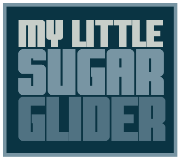Hello!
Hello and thank you for visiting my website. I am have been slave to Sugar Gliders (Petaurus breviceps) since 1997.
Thanks to some recent biological studies, we have found that our American species of Sugar Glider come from the rain forests of Papua, New Guinea and are similar to, but not the same species that live in Australia or Indonesia.
These are amazing little animals who were once imported into our pet markets in the early 1990’s, but by the end of that decade, were placed on an endangered list and were no longer imported by the millennium. We have tight gene pools in the states with these guys, which it is so important to only find a breeder who breeds with full lineage to ensure you get the healthiest gliders possible. Inbreeding doesn’t carry out favorably with their health and well-being.
I live in Lake Havasu City, AZ and I strive to educate people correctly on proper care and bonding with these unique exotics.
When you get your pair of sugar gliders from me, you are not only getting my many years of experience, but you will have me after the purchase as well. I will present you with a healthy pair of animals that were properly bred. All of my pairs have a minimum of 5 generations on both sides (most have many more generations) and before they are even put together, I run tests to make sure they are not related. We know just one like relative within the first 4 generations; can produce joeys with genetic defects of the major organs that can shorten their lives considerably. Breeding properly with lineage can eliminate these type of issues.
I did say “Pair”. I did. Sugar Gliders are colony animals by nature. Despite what the pet stores or mill breeders may tell you, it’s not very kind to keep them as singles. A responsible breeder will never sell you just one, unless you already have one at home in need of a like-aged companion.
A lone glider can suffer stress which can lead to depression, sickness and possible self-mutilation. Often times, I have been contacted by an owner who was sold just one sugar glider by an uncaring source. The animal refuses to bond with them, mostly because the sugar gliders feel safer in numbers. Once they get a new friend, it turns from night to day in the bonding process and now the little baby wants to interact with the owner.
I do what is right for the animals. I only look for homes for my animals that want to do what is right for them.
Sugar gliders are also by nature, hardy animals. There are no known vaccinations for them and if bred properly and fed a proper diet, they are given the best chance possible for a good, healthy life.
However, there can be some set-backs along the way. Accidents can happen. Sugar gliders can get injured and may require immediate vet attention. A broken leg or deep wound, may be very costly to care for with a qualified exotics vet, so it’s important that you are prepared financially for these type of situations, and that you have found a competent exotics vet near you.
Sugar gliders can contract parasites from other animals, food and water sources. No matter how clean or how careful we are, we must do preventatives. Since sugar gliders are still this side of wild, if they are sick, they can hide it for a long period of time and then it may be too late. For the pet owner, a yearly vet wellness check up with parasite screening is highly recommended.
As a responsible breeder, I am USDA so that means my vet does a yearly home inspection with me and she is available to me by private cell 24/7. But I also take things a bit further and make sure to collect several samples 5 times a year from my parent gliders, and send it to a lab near Dallas, VETDNA.COM.
It’s the most accurate testing we have for these type of things. Since all of my gliders are in the same room in my home, if one has them, they more than likely all would. In this type of testing, if just one of my gliders were to have them present, it cannot hide in the DNA fecal sampling. I have been very successful in having negative testing come back to me time and time again in my home. I am happy to send you the most recent results if you ask me.
Also, whenever I receive a new sugar glider from another breeder, they go into quarantine until their test samples are sent in as well. This is fantastic piece of mind for me, for my clients and I do urge other breeders to do the same. The cost for the test is very cost effective for breeders and pet owners alike.
You are also receiving joeys that are weaned onto a tried and true diet in which the base is imported from Australia and has been in service with rescuers there for close to 40 years. Many years ago, an exotics veterinarian in this country tweaked it a bit from the original version by adding eggs, honey, bee pollen and water for the needs of our breeding and pet gliders in captivity. This diet has kept many gliders happy and healthy in the States for a very long time. The needs of our pets and breeders will vary from the recused wild animals of Australia that will be released back into captivity. My facility has used this upgraded American version nearly 15 years. I can also supply you with this diet as well in my store, to make sure you are receiving one of the best diets out there for sugar gliders.
As with all things, there are several copy cat versions out there made in the USA that are filled with an FDA drug banned for human use due to its proven ability to cause cancer and other ailments. At this time, there is no laws governing animal food as closely, so we must be very careful about what we feed our sugar gliders. I can direct you to the places in which you can purchase the True Australian Diet with peace of mind.
When I first started with gliders in 1997, there were only a handful of diets available to us. Some are still talked about in books you may find published in the 1990’s, and some websites still reference them. Some were even feeding cat food. They are all outdated. Back then, we would tell people gliders in our homes could have a lifespan of 5 to 8 years or more. With advent of the newer, higher protein diets such as Wombaroo, their life-spans have greatly increased to 10 to 12 years and even more. I would say that the proof is in the pudding. We have come a long way from the original “cat-food” diets fed to these amazing creatures. I can teach you how to continue with this diet to make sure we can help them live to their full potential. If you follow my advice on the right diet, you should avoid costly vet issues with health down the road.
There is a lot to the initial bonding process with your sugar gliders. No matter how much I work with joeys in my home, you will be a stranger to them, and you will need to work with them on your end daily to form your own trust bond with them. The efforts will be well worth it in the end, and I will be here to help you any way that I can throughout this process.
Sugar gliders are not recommended for very young children. I have never told anyone that I will guarantee a bond between young children or babies with sugar gliders. Older, mature children under the strict supervision of their parents is acceptable. I am very cautious about selling to minors and a parent must be there and just as involved with educating themselves with the animals. If a child comes to me and does not wish to involve the parent, or if the parent doesn’t want to learn along with the child, I will turn them away. These are high-maintenance animals and I cannot stress enough that you are going to be putting a lot of work into them when they first come to your home, in order to form your own trust bond with them. You will be a stranger and they will be afraid of you. Once this bond is established, it’s all worth it, but you must provide ample time with them daily and patience, or you will keep losing what progress you made with them before and may have to start again from square one. Sugar Gliders are not for everyone. But I am here to help you make an informed decision and to get through the bonding period.
In further segments of my website, I will go over these and many things in greater detail.
I do know people love to have photos of their joeys, but at any given time, I can have up to 30 animals that need to be photographed. Plus we also breed Leopard Geckos. It’s just my husband and I and there are only so many hours in the day. We can only take photos of your sugar gliders as time permits.
If you have any other questions, please do not hesitate to ask me.
Yours in Marsupials,
Danielle G.



